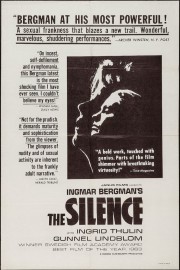The Silence
One of the most difficult experiences I’ve had with a film in the past decade was with Ingmar Bergman’s “Through a Glass Darkly,” the second part of his “Silence of God” trilogy that includes “Winter Light” and “The Silence.” Reading about the film could not necessarily prepare me for it, and I had a frustratingly hard time with it. In the coming years, I will be giving that film another chance, especially now that “The Silence” has given me a similar experience. That said, “The Silence” was much more successful for me on the first pass because I expected something vague on a thematic level, but nonetheless emotional on a personal level. I don’t mean to insult the great Swedish filmmaker by calling his film “vague,” however, but only to describe how he approaches his subject in this film. It’s a bold approach, and an effective one, as well, as silence is truly deafening throughout the film’s 95 minutes.
The film begins with two women and a boy riding a train; at the end, only one woman and the boy will be riding another train. The three are headed home after a trip, and as the train commences, the boy (Johan, played by Jörgen Lindström) goes into the hall and looks around. Outside, he sees a lineup of tanks; wherever they are, there is war on the horizon. Neither the women nor Johan are in a terribly joyous mood, and we get the distinct impression that it isn’t pending war causing them to feel that way. They all check into a hotel room, with Ester (Ingrid Thulin) taking the main room and Anna (Gunnel Lindblom) and Johan, her son, taking an adjoining room. Ester and Anna are sisters, and Ester is ill, while Anna appears to want more to just be away from Ester and go out on the town. There’s friction between the sisters, but it goes largely undiscussed. Silence is the preferred mode of communication between those two, although Ester does have a bond based on language with Johan that will be important as the weekend in the hotel commences.
Images are the preferred way of communicating his characters’s thoughts and feelings for Bergman, and the face is the most powerful one we see in “The Silence.” Photographed by Bergman’s great cinematographer, Sven Nykvist, the faces of Anna, Ester and Johan communicate such emotional distance that it’s hard to imagine a poet doing a better job. Johan’s face is squarely in frame as he moves around a bed, as we hear the noises of Ester’s pain on the soundtrack. Anna’s disregard for Ester, and boredom for the trip they are embarking on, is obvious as she hooks up with a waiter, although one wonders if that offers her anything beyond temporary satisfaction. Ester’s joy seems to come out as she manages to communicate with the hotel porter (Hakan Jahnberg) even though they don’t share a common language, and she seems to have a nice bond with Johan, writing him a letter with the words of the language they are surrounded by that she has learned; as a book translator, that is not surprising. For Anna, there doesn’t seem much joy at all, just a sense of responsibility that extends to her relationship with her son. Bergman has always been a more cerebral filmmaker than an openly joyful one (his adaptation of “The Magic Flute” being an exception), but even for him, “The Silence” feels bleak. I mentioned that the film is part of his “Silence of God” trilogy, but don’t look for God anywhere in the text of this film. His voice is as silent in what happens here as the resentment between Anna and Ester throughout most of the film. By emphasizing images over words, Bergman places his audience in the same position God is in here- unable to do anything to prevent what happens from happening, only capable of looking on in quiet agony as it happens. The result is painful and powerful to witness, and sometimes, difficult to comprehend, allowing us to identify with how Johan probably is experiencing this moment, as well.










